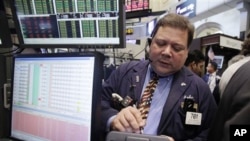Wall Street analysts searching for reasons for the U.S. stock market's sharp swings in early August point to high unemployment, the European debt crisis and other basic economic problems. But some also suspect what is known as high-frequency trading, computerized trades that happen in milliseconds.
The stock market used to be a human scene of men shouting price quotes and making trades on the floor of the New York Stock Exchange. Now it is high-speed computers, operating according to complex mathematical formulas, that run the show.
Using automated trading strategies, computer programs bid, buy and sell thousands of times a second, garnering profits of a penny or less per trade: small change that adds up to millions in profits each day, and billions each year.
Some Wall Street analysts suspect that high-frequency trading, as it is called, is also partly responsible for recent sharp swings in the market of hundreds of points in a single day. They say that although such volatility is likely a reflection of basic economic problems, the swings may be amplified by a trading time range of thousandths - or even millionths - of a second.
In a recent analysis of Standard & Poor's 500-stock market index since 1962, The New York Times found that large price swings of three or four percent, have happened far more frequently in the last 10 years than in the preceding 40.
Joe Saluzzi, co-head of equity trading at Themis Trading in New Jersey, says that the scene today on the floors of the stock exchanges is akin to a historical exhibit.
"It's no longer what you see on TV, guys with colored jackets running around the floor," Saluzzi says. "That's the show, that's the TV studio. The equity market now is a bunch of co-located computers strung together by a bunch of wires, everyone trying to race to zero. The speed of light is the goal, the speed of light is what we're looking at now."
These "co-located" computers, Saluzzi explains, are banks of servers placed as close as possible to broker and exchange company offices. The reason for such proximity is to minimize the time that data spends traveling - at nearly the speed of light - along fiber-optic lines. Receiving and evaluating information almost instantaneously in a dynamic feedback loop, the computers float, revise, complete and cancel trades - all based on what other high-frequency trading programs may be about to do, or have just done.
"A millisecond can mean millions of dollars to the success of your strategy," explains Andrew Haines, chief information officer of online trading broker Gain Capital. "Having a one, two, three-millisecond advantage over other traders may mean that you get into a trade at a preferable price."
Such trade has exploded over the last 10 years, and now accounts for an estimated 70 percent of all stock trades in the U.S.
But it also has raised controversy. Some critics say that the fastest computer trading companies have an unfair advantage in being able to detect price moves a millisecond before other traders, giving them an edge in responding just as quickly with a buy, sell or cancel order. They say that such hyper-fast trading distorts the market.
Other analysts respond, however, that the advantage has always been with traders who are quickest to gather and act upon changing market conditions, and that automated trading strategies are only the latest - and likely the ultimate - example of that.
The issue that has received most attention, however, is speed trading's implication in runaway market swings, like the one that took place on May 6, 2010. In less than half an hour, the Dow Jones Industrial Average dropped more than 600 points and then shot part of the way back up again, recovering much of its losses. Following that wild ride, the Securities and Exchange Commission (SEC) ordered preventative measures called "circuit-breakers."
"Basically, what they mean is that when a stock has moved by a large amount in a short period of time, there's a trading halt," says Joel Hasbrouck, a professor at New York University's Stern School of Business. He thinks the circuit breaker system is working to prevent extreme swings, but says that the SEC needs to implement ongoing tracking of market moves. At present, he says, the SEC has no means for detecting potential abuses, such as attempts to drive a price in a particular direction in order to capitalize on it.
But Joe Saluzzi at Themis Trading contends that the core problem is an "unbalanced" market, one that is overly dominated by speed-trading that looks only as far ahead as the next millisecond. He says the result is that stock prices lose any connection to reality outside the financial markets, to a company's real-world value.
"The stock market used to be a predictor of the future economy," Saluzzi notes. "Now I think the stock market is a backwards predictor. It doesn't tell you, it's not forecasting. It's forecasting the next microsecond move. It's not forecasting the next six months, because most of the volume is being dominated by guys who could care less what goes on in six months. So, how could you think the price is being set correctly?"
Yet Joel Hasbrouck of NYU observes that speed trading often reduces volatility. "In normal circumstances, high-frequency traders act as market makers," Hasbrouck says. "That is, they stand by passively waiting to buy or sell from whoever comes into the market needing to trade. In that capacity, they actually help stabilize the market."
The difference, Saluzzi notes, is that unlike market makers, high-frequency traders are free to leave the market, declining to buy or sell. Such sudden withdrawals by the major players create vacuums in which prices fall or shoot up dramatically in seconds. That's one reason why most observers say that more reform is needed to guard against instability and other dangers in this brave new world of trading.






